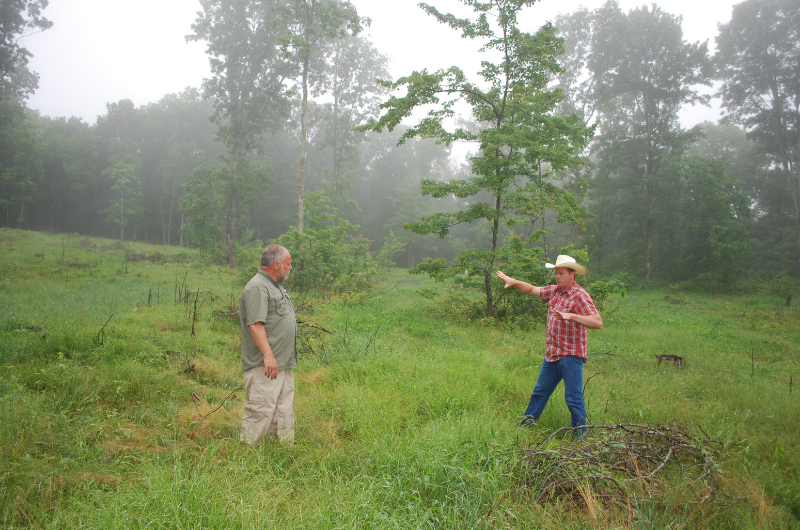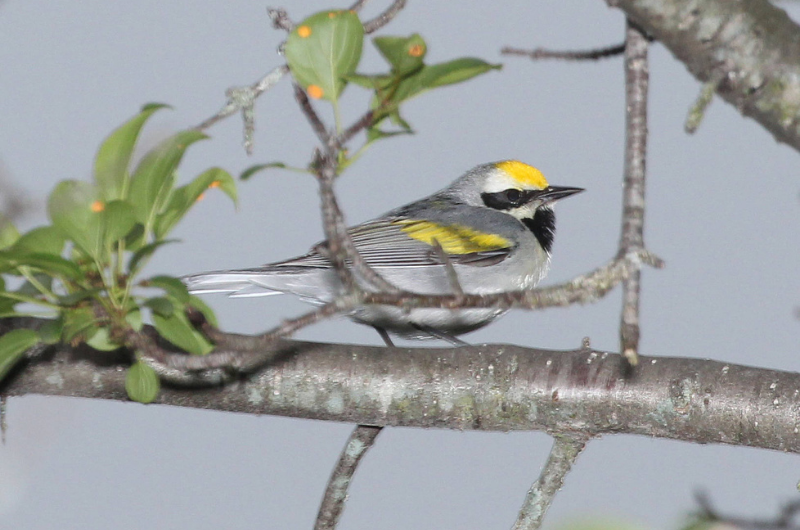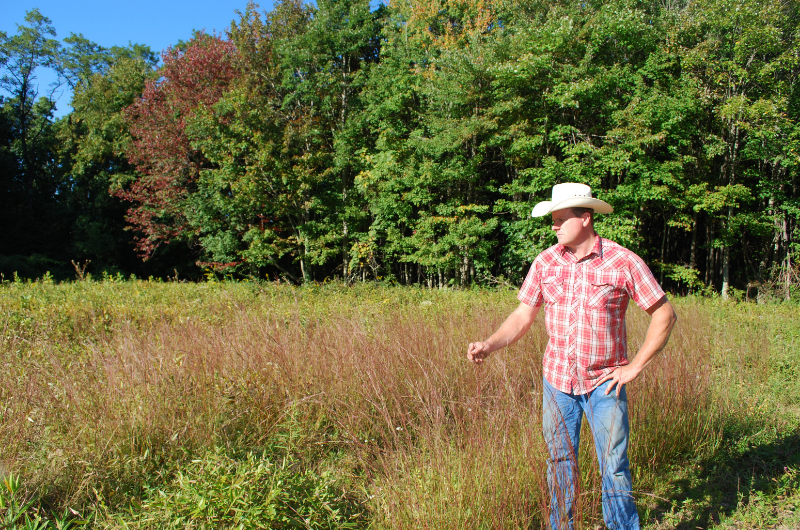During the past 120 or so years, our attitudes about public forests have become more complex as demands on these shared, treasured places have grown and evolved.
For much of the first half of that period, profiteers, looking to extract every last dollar from our woodlands, leveled large swaths of forest, causing extreme erosion, decimating wildlife and harming water quality and native fish such as brook trout.
For much of the second half of that period, preservationists often held the upper hand, sometimes restricting logging. As fewer forests were logged, many matured into uniformly aged tree stands, lacking the natural diversity they once had. While certain game populations, like white-tailed deer, are too large in some places, they have declined in others, and the lack of habitat diversity is a factor. Also on the decline are species of neotropical songbirds that need young forests to flourish.
 This forest was thinned to benefit deer and other wildlife that prefer clearings and early successional forest, which features an open canopy in the trees, permitting sunlight for grass, shrubs or young trees.
This forest was thinned to benefit deer and other wildlife that prefer clearings and early successional forest, which features an open canopy in the trees, permitting sunlight for grass, shrubs or young trees.
A number of our nation’s policymakers have not been helpful. Some want to restrict all timber cutting, especially on our public lands. A no-cut philosophy is not always the best conservation strategy.
Meanwhile, other lawmakers don’t seem to care about the existence of public land at all. They call for selling off our public lands or leasing them for energy development – in effect kicking out hunters, anglers and other outdoor enthusiasts.
But the health of our public forests also affects the millions of Americans – urban, suburban and rural – who never hunt, fish or experience the outdoors. Many headwater streams and rivers flow through these public forests having been filtered by forest land, which benefits communities downstream. The U.S. Forest Service reports that 180 million people in more than 68,000 communities rely on these forests to capture and filter drinking water. Extractive industries, whether oil and gas drilling, mining or logging, can do great harm to the drinking water.
180 million people in more than 68,000 communities rely on healthy forests to capture and filter drinking water.
So how do we get it right on our shared public lands? For nearly 100 years, the League has been one of the voices of moderation and good science for forestry and other conservation fields. Jared Mott, Izaak Walton League’s Conservation Director, provides insight from our perspective.
“The League has extensive member-adopted policies regarding public forest management that acknowledge the importance of tools like timber cutting and prescribed burning, but also the necessity of protecting parcels with unique characteristics such as remoteness, critical migration corridors or remaining old growth,” Mott says. “Management of our nation’s public forests should be balanced toward wildlife, recreation and other public benefits, not toward harvesting the most board feet of lumber possible.”
So, getting it right means sustainable ecosystem management, which balances multiple goals for the long-term health of the forest. This could benefit game and non-game species that require young forest habitat, but at the same time protect water sources and rare old-growth forests and mitigate destructive wildfires.
One concern is that uniformly mature forests lack young growth that limits habitat favored by deer, turkey, woodcock and grouse. That early succession forest is also needed by some songbirds such as golden-winged warblers, prairie warblers, yellow-breasted chats and white-eyed vireos.
 The increasingly rare golden-winged warbler prefers woodland borders and young forest habitat.
The increasingly rare golden-winged warbler prefers woodland borders and young forest habitat.
Many parts of the U.S. have far too many deer that are severely damaging public forests by over-browsing (see “The Dangers of Too Many Deer,” Outdoor America, 2016, Issue 1). But some organizations would like to see more game-friendly habitat in forests.
Kip Adams, Chief Conservation Officer for the National Deer Association (NDA), weighs in:
“The science is very clear about the value of multiple age classes within forested environments,” he says. “At NDA, we believe that the proper management of our forests is vital to the preservation of white-tailed deer, wildlife habitat and our hunting heritage. Proper forest management benefits a suite of game and non-game species, and the current science supports active management practices.
“Given that few wildlife species survive exclusively in a single age class of forest…management programs are necessary to maintain healthy forests and biodiversity in the wildlife communities.”
To promote young or early successional forest habitat, which adds diversity to the landscape, Adams’ group has favored a variety of logging strategies and controlled-burn projects in Southern Appalachian forests managed by the U.S. Forest Service. These practices can help provide the range of habitat conditions that emulate the natural disturbances such as wind-caused blowdowns and fires. Those events historically opened up the forest to new growth before farming, development and other factors disrupted the natural patchworks of forest diversity.
 This clearcut now features little bluestem (Schizachyrium scoparium), a tall grass that provides food for many songbirds.
This clearcut now features little bluestem (Schizachyrium scoparium), a tall grass that provides food for many songbirds.
To be fair, mature forests – and especially true old-growth forests – also have many vital features, including dead trees, or snags, that provide homes for tree swallows, flying squirrels and other cavity-nesting animals.
Getting forest management right depends on many things. The truth is we need all kinds of forests in their varied stages – from rare old growth, wilderness and roadless areas to recent clearcuts and every age of forest in between. Some songbirds and gamebirds (think yellow-breasted chats and grouse) need regenerating woodlots of five to 10 years of age while others do best with pole timber or stands 20 to 30 years old.
And while fostering diverse forests, we also need to make sure that we protect the rivers and headwater streams on our public lands. The more diversity we have in our national forests and other public lands, the better it will be for America’s wildlife and its people.
Forest Management is Complex
Jim Furnish, former Deputy Chief of the U.S. Forest Service and author of Toward a Natural Forest, visited virtually every one of our 125 national forests during his 34-year career.
“Forest management is highly varied and quite complex,” he says. “Whether you’re talking about reducing risks of these horrible fires we’re having, trying to improve wild turkey habitat or restore stream health, no ‘one-size-fits-all’ solutions exist.”
This is especially true in the West where, for example, California alone has 20 different national forests. Furnish says that both lightning and humans cause the huge fires sweeping vast areas. Most burned areas experience light- to moderate-severity fires, with many surviving trees.
Forest management, such as thinning trees and lightly burning forest debris, can reduce risk of severe fire and loss of homes. But such practices are very costly, and tens of millions of acres are in need. Logging can help in some forests, notably Ponderosa pine. But in other areas dominated by lodgepole pine, it’s foolish to expect benefits from logging, Furnish emphasizes.
“The biggest ally we have—whether it’s for combating climate change, forest health, wildlife habitat, or clean air and water—is diversity,” Furnish concludes. “American forests were once rich in diversity, and the best forest management aspires to restore this essential character.”